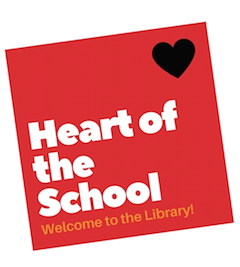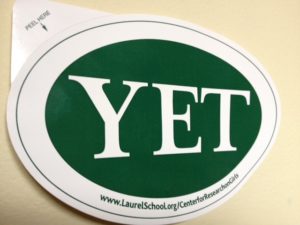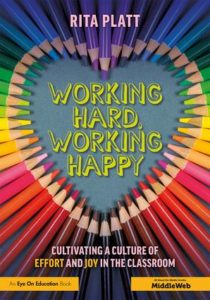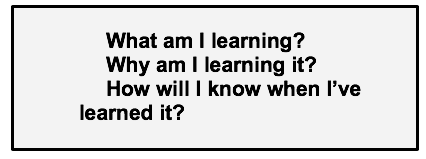Fresh Insights into the Hard Work Students Do
A MiddleWeb Blog
 Guess what? I’m learning to communicate with sign language! I started learning because I have a new student who is deaf and uses Signed Exact English as her main strategy for communication. I wanted to be sure that she had at least two people she could speak to directly, her interpreter and her principal (me).
Guess what? I’m learning to communicate with sign language! I started learning because I have a new student who is deaf and uses Signed Exact English as her main strategy for communication. I wanted to be sure that she had at least two people she could speak to directly, her interpreter and her principal (me).
I attend classes for two hours a week, do formal practice and review with vocabulary at least fifteen minutes per day, and constantly practice by saying everything I can in sign language (never mind that my family is sick of me and people in the grocery stores give me funny looks).
As I watch my own children grow, I’m reminded of what it felt like to be a tween or teen. So much learning! Many teachers are life-long learners to be sure. But the kind of learning we most often engage in is deep rather than wide. That’s to say, we work on honing our craft, learning more in the content-area we teach, or targeting methods, strategies, and pedagogy.
That’s different from the kind of learning we ask students to do. Much of their learning is wide. They are learning totally new and sometimes really hard concepts. Fractions anyone? Newton’s Laws? Writing a strong thesis? My own children are struggling with those concepts now. Which means I am struggling with them too.
As any parent of a teen or tween probably knows, all that hard work at school means there is a plethora of strong emotions present on any given night at my house. I see some of the same sentiments in the classroom. Ever heard any of these phrases?
Why do I even have to know this?
I don’t care about this at all.
I can’t do this. It’s too hard.
It is easy to become frustrated with students (or our own children) when it feels like they aren’t trying. But you know what? Learning is really hard! It’s important for teachers (and parents) to keep a toe in the learning pool so they can empathize.
Hey, Teacher? Be a Learner!
Over the years I’ve worked to remind myself how it feels to learn something new. I’m not talking about going to a conference or reading a professional book (though I do those things too). I am talking about learning something really new. Something that helps me remember what it’s like for my students and challenges my assumptions about what it means to be a learner.
When I turned 40, I learned to play the guitar. I had never learned to read music or played another instrument in my life. I had to start with the scale, learning chords, and tons of practice, practice, practice. Guess what? I learned to play!
When I was 45, I began vocal training (I wanted to learn to sing while I played!). Again, the learning was totally new to me. I had to work hard to hold a tune and to hit that high note. But, guess what? I can sing on key (most of the time).
So, now that I’m 50, I’m learning sign language.
What I Learned About Learning
Learning sign language (and guitar and how to sing) as an adult has given me great insight into the learning process. A touchstone for me as a teacher comes from Dan Pink’s book, Drive: The Surprising Truth About What Motivates Us. In that book Pink looks at the research on motivation and finds that there are three factors which lead to great motivation.
- Purpose – Having a reason for what we do or learn.
- Mastery – Being able to see the impact our work or learning has or the growth we are making toward a goal.
- Autonomy – Having a measure of control over what we do or learn.
If you’re not familiar with Pink’s work, I encourage you take the time to watch this RSA Animate Video of him talking about his research. I promise you won’t be disappointed; he is a wonderful speaker. (And you needn’t take my word for it – look at the number of views!)
Every time I learn something new, I am reminded of how purpose, mastery, and autonomy must be a part of all good lesson design. When I am working on my signing, there is a clear purpose (to communicate with my student), a sense of autonomy (I chose to learn this!), and not only a clear route to mastery (practice, practice, practice) but a way to easily gauge my growth (how much I can say and understand in sign). Honestly, when those three keys are in place, learning is wonderful! It just feels good.
In Your Classroom
Earlier in this post I shared some of the ideas and concepts my own children are learning, including how to add, subtract, multiply, and divide fractions and mixed numbers, how to write a strong thesis that doesn’t sound formulaic, applications of Newton’s laws, and most recently how the Bill of Rights frames our legal system.
Very often, when I am supervising homework at our kitchen table, I hear these plaintive questions:
Why do I even have to know this?
How will this ever be useful to me?
The truth is, sometimes there isn’t a great answer to these questions. Sometimes we learn things because they will help us learn other things later. Sometimes we learn things because they help us grow our brains. Sometimes we learn things so we can help other people accomplish something.
The key is to be very upfront with students and to really think about how you can articulate the purpose of the work you ask students to do.
Purpose: Make Learning Targets Clear
If you’re sick and tired of the term “learning targets,” you’re not alone. Mandates associated with learning targets – including posting “I can” statements, “unpacking standards,” and the ever changing edu-vocabulary (learning targets, learning intentions, objectives, essential learnings, etc) – have left many teachers with a high level of learning-target fatigue. I have felt that myself.
But, fatigue aside, learning targets are important, and we can’t let misguided interpretations and arbitrary rules lead us away from sharing this big idea about learning with our students.
Helping students see the purpose for the work they do is critical to motivation. Having observed many classrooms in all grades over the course of my career, I can certify that not only do students often not know why they are doing something, they sometimes don’t even know what they are doing.
In the best-case scenario, a visitor to your class could ask any student what they were learning and why, and every student could answer in a simple way. Of course, that is not possible if learning targets aren’t clear. When they are clear, they should help teachers and students answer the three questions shared in this box.
Mastery: The Power of “Yet”
When I am helping my own kiddos with their learning, I hear some pretty defeatist comments:
I don’t care about this at all.
I can’t do this. It’s too hard.
Sometimes our students can’t see themselves as capable of mastery. We have to help them build their growth mindset and confidence. In The Most Powerful 3-Letter Word a Parent or Teacher Can Use, Daniel Coyle writes that “kids love to announce they’re not good at something.” One of the cures for this type of defeatism, says Coyle, is to teach children to add the word yet to the end of any such declarations.

Help students practice using the subtle power of “yet”! When introducing learning targets, as shared above, ask students to try formatting their statements with an eye for the future. Read through the examples below.
- Fractions seem so hard to me! I can’t work problems easily yet, but I know if I try to stay calm and focused, I will learn how.
- I can’t figure out the main idea of a text yet, but I know Mrs. Platt will teach me and I’ll be able to soon!
- Even though I can’t give examples of how Newton’s Laws apply to my life yet, I will be able to after I read and think about the text on the topic.
- I can’t yet write a strong thesis statement, but if I follow the models and think about my topic, I will be able to by the end of the quarter.
To further help kiddos see themselves as capable of mastering difficult new learning, try helping them set, meet, and monitor their own goals. I wrote about how in an earlier post here for The Heart of the School blog.
Autonomy: Offer a Little Bit of Choice
While we can’t always give students a choice about what they learn, we can always offer at least a modicum of choice about how they learn it and how they let us know what they’ve learned. Try letting students choose:
- where to sit.
- how to demonstrate knowledge.
- who to work with.
- what the timeline is.
- how to practice.
Every little bit of autonomy we give to students can make a big difference in their motivation and ultimately in their learning.
Be a Learner Too!
Every time I take on a new learning challenge, I learn so much about learning. I promise you will too. I encourage all teachers to try stretching outside of their comfort zones to learn. Learning is hard, to be sure, but it is so very satisfying when we do.






































